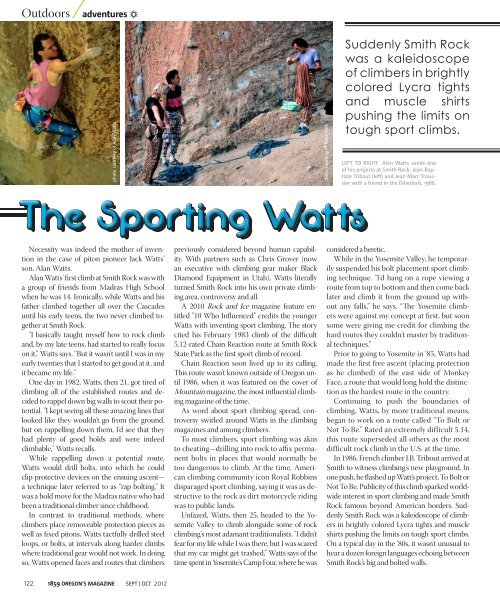Create successful ePaper yourself
Turn your PDF publications into a flip-book with our unique Google optimized e-Paper software.
Outdoors<br />
adventures<br />
photo courtesy of Alan Watts<br />
photo courtesy of Mike Volk<br />
Suddenly Smith Rock<br />
was a kaleidoscope<br />
of climbers in brightly<br />
colored Lycra tights<br />
and muscle shirts<br />
pushing the limits on<br />
tough sport climbs.<br />
LEFT TO RIGHT Alan Watts sends one<br />
of his projects at Smith Rock. Jean Baptiste<br />
Tribout left and Jean Marc Troussier<br />
with a friend in the Dihedrals, 198.<br />
The Sporting Watts<br />
Necessity was indeed the mother of invention<br />
in the case of piton pioneer Jack Watts’<br />
son, Alan Watts.<br />
Alan Watts’ first climb at Smith Rock was with<br />
a group of friends from Madras High School<br />
when he was 14. Ironically, while Watts and his<br />
father climbed together all over the Cascades<br />
until his early teens, the two never climbed together<br />
at Smith Rock.<br />
"I basically taught myself how to rock climb<br />
and, by my late teens, had started to really focus<br />
on it,” Watts says. “But it wasn't until I was in my<br />
early twenties that I started to get good at it, and<br />
it became my life."<br />
One day in 1982, Watts, then 21, got tired of<br />
climbing all of the established routes and decided<br />
to rappel down big walls to scout their potential.<br />
"I kept seeing all these amazing lines that<br />
looked like they wouldn't go from the ground,<br />
but on rappelling down them, I'd see that they<br />
had plenty of good holds and were indeed<br />
climbable," Watts recalls.<br />
While rappelling down a potential route,<br />
Watts would drill bolts, into which he could<br />
clip protective devices on the ensuing ascent—<br />
a technique later referred to as “rap bolting.” It<br />
was a bold move for the Madras native who had<br />
been a traditional climber since childhood.<br />
In contrast to traditional methods, where<br />
climbers place removeable protection pieces as<br />
well as fixed pitons, Watts tactfully drilled steel<br />
loops, or bolts, at intervals along harder climbs<br />
where traditional gear would not work. In doing<br />
so, Watts opened faces and routes that climbers<br />
previously considered beyond human capability.<br />
With partners such as Chris Grover (now<br />
an executive with climbing gear maker Black<br />
Diamond Equipment in Utah), Watts literally<br />
turned Smith Rock into his own private climbing<br />
area, controversy and all.<br />
A 2010 Rock and Ice magazine feature entitled<br />
"10 Who Influenced” credits the younger<br />
Watts with inventing sport climbing. The story<br />
cited his February 1983 climb of the difficult<br />
5.12-rated Chain Reaction route at Smith Rock<br />
State Park as the first sport climb of record.<br />
Chain Reaction soon lived up to its calling.<br />
This route wasn’t known outside of Oregon until<br />
1986, when it was featured on the cover of<br />
Mountain magazine, the most influential climbing<br />
magazine of the time.<br />
As word about sport climbing spread, controversy<br />
swirled around Watts in the climbing<br />
magazines and among climbers.<br />
To most climbers, sport climbing was akin<br />
to cheating—drilling into rock to affix permanent<br />
bolts in places that would normally be<br />
too dangerous to climb. At the time, American<br />
climbing community icon Royal Robbins<br />
disparaged sport climbing, saying it was as destructive<br />
to the rock as dirt motorcycle riding<br />
was to public lands.<br />
Unfazed, Watts, then 25, headed to the Yosemite<br />
Valley to climb alongside some of rock<br />
climbing's most adamant traditionalists. "I didn't<br />
fear for my life while I was there, but I was scared<br />
that my car might get trashed,” Watts says of the<br />
time spent in Yosemite's Camp Four, where he was<br />
considered a heretic.<br />
While in the Yosemite Valley, he temporarily<br />
suspended his bolt placement sport climbing<br />
technique. "I'd hang on a rope viewing a<br />
route from top to bottom and then come back<br />
later and climb it from the ground up without<br />
any falls,” he says. “The Yosemite climbers<br />
were against my concept at first, but soon<br />
some were giving me credit for climbing the<br />
hard routes they couldn't master by traditional<br />
techniques.”<br />
Prior to going to Yosemite in ’85, Watts had<br />
made the first free ascent (placing protection<br />
as he climbed) of the east side of Monkey<br />
Face, a route that would long hold the distinction<br />
as the hardest route in the country.<br />
Continuing to push the boundaries of<br />
climbing, Watts, by more traditional means,<br />
began to work on a route called “To Bolt or<br />
Not To Be.” Rated an extremely difficult 5.14,<br />
this route superseded all others as the most<br />
difficult rock climb in the U.S. at the time.<br />
In 1986, French climber J.B. Tribout arrived at<br />
Smith to witness climbing’s new playground. In<br />
one push, he flashed up Watt’s project, To Bolt or<br />
Not To Be. Publicity of this climb sparked worldwide<br />
interest in sport climbing and made Smith<br />
Rock famous beyond American borders. Suddenly<br />
Smith Rock was a kaleidoscope of climbers<br />
in brightly colored Lycra tights and muscle<br />
shirts pushing the limits on tough sport climbs.<br />
On a typical day in the ’80s, it wasn’t unusual to<br />
hear a dozen foreign languages echoing between<br />
Smith Rock’s big and bolted walls.<br />
122 <strong>1859</strong> oregon's mAgAzine SEPT OCT <strong>2012</strong>

















